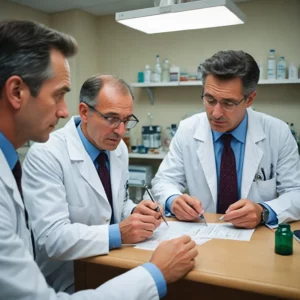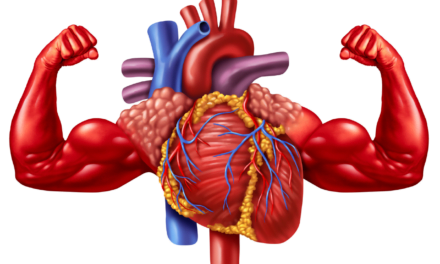Testosterone’s Role
What is testosterone?
Testosterone is a crucial androgenic hormone primarily produced in the testes of males and, to a lesser extent, in the ovaries of females and the adrenal glands of both sexes. This steroid hormone plays a pivotal role in male sexual development, reproductive function, and overall physiological homeostasis. Synthesized from cholesterol, testosterone’s production is regulated by the hypothalamic-pituitary-gonadal axis, ensuring a delicate balance of hormonal levels throughout the body (1).
Normal testosterone levels in men
The normal range for testosterone levels in adult males typically falls between 300-1000 nanograms per deciliter (ng/dL), with variations based on age, time of day, and individual physiology. It’s important to note that testosterone levels naturally fluctuate throughout the day, generally peaking in the morning and declining towards evening. Age-related decline in testosterone production is also a well-documented phenomenon, with levels decreasing by approximately 1-2% annually after age 30 (2).
Functions of testosterone in the male body
Testosterone exerts a multifaceted influence on male physiology, encompassing both anabolic and androgenic effects. Key functions include:
Sexual development: Drives the maturation of male reproductive organs and secondary sexual characteristics during puberty.
Muscle mass and strength: Promotes protein synthesis and muscle hypertrophy.
Bone density: Enhances bone mineralization and maintains skeletal integrity.
Fat distribution: Influences body composition by regulating fat metabolism and distribution.
Red blood cell production: Stimulates erythropoiesis in the bone marrow.
Libido and sexual function: Modulates sexual desire and supports erectile function.
Mood and cognitive function: Influences neurotransmitter systems affecting mood, memory, and spatial abilities.
Sperm production: Essential for spermatogenesis and male fertility (3).
Signs of High Testosterone in Men
Changes in Sexual Health
Elevated testosterone levels can significantly impact male sexual function, manifesting in paradoxical ways. Increased libido, characterized by heightened sexual desire and frequency of sexual thoughts, is often observed. However, this hypersexuality may be accompanied by potential erectile issues, as excessive testosterone can lead to a negative feedback loop, disrupting the delicate hormonal balance necessary for optimal erectile function.
Mood and Behavioral Changes
Supraphysiological testosterone concentrations can induce notable alterations in mood and behavior. Increased aggression, colloquially termed “roid rage” when associated with anabolic steroid use, may manifest as heightened irritability, confrontational behavior, or even violent outbursts. Concomitantly, individuals may experience unpredictable mood swings, oscillating between euphoria and depression, potentially exacerbating pre-existing mental health conditions.
Physical Changes
Dermatological manifestations of high testosterone include increased sebum production, leading to acne vulgaris and oily skin. This hyperandrogenic state can exacerbate existing acne or trigger new outbreaks, particularly on the face, chest, and back. Additionally, accelerated body hair growth (hirsutism) may occur, with enhanced terminal hair development in androgen-sensitive areas such as the chest, abdomen, and back.
Cardiovascular Effects
Testosterone’s impact on the cardiovascular system is complex and potentially deleterious when in excess. Blood pressure changes, typically presenting as hypertension, may occur due to increased fluid retention and alterations in vascular tone. Moreover, elevated testosterone levels are associated with an increased risk of blood clots, potentially leading to thromboembolic events such as deep vein thrombosis or pulmonary embolism.
Hormonal Imbalances
Paradoxically, excessive testosterone can lead to reproductive dysfunction. Decreased sperm production (oligospermia or azoospermia) may occur due to negative feedback on the hypothalamic-pituitary-gonadal axis, suppressing endogenous testosterone and sperm production. Concurrently, testicular atrophy may manifest, resulting in shrinking testicles, a condition known as hypogonadism paradoxicus.
Sleep Disturbances
High testosterone levels can significantly disrupt sleep architecture. Insomnia, characterized by difficulty initiating or maintaining sleep, is frequently reported. Furthermore, there’s an increased risk of sleep apnea, a potentially serious sleep disorder characterized by repeated breathing interruptions during sleep, which may be exacerbated by testosterone-induced changes in upper airway musculature and body composition.
Fluid Retention
Excessive testosterone can lead to fluid retention, manifesting as edema in the extremities. Swelling in legs and feet, often more pronounced towards the end of the day, may be observed. This fluid accumulation can result in visible sock lines, where the elastic band of socks leaves a noticeable indentation on the skin, indicating significant peripheral edema.
Causes of High Testosterone
Natural factors
Endogenous hyperandrogenism, or naturally occurring high testosterone levels, can stem from various physiological and pathological conditions. Certain genetic predispositions may lead to increased testosterone production or decreased testosterone metabolism. Tumors of the testes or adrenal glands, such as Leydig cell tumors or adrenocortical carcinomas, can autonomously secrete excessive amounts of testosterone. Additionally, congenital adrenal hyperplasia, a group of inherited disorders affecting adrenal gland function, may result in elevated androgen levels, including testosterone.
Testosterone replacement therapy
Iatrogenic hyperandrogenism can occur as a consequence of testosterone replacement therapy (TRT), which is prescribed for men with clinically diagnosed hypogonadism. While TRT aims to restore physiological testosterone levels, improper dosing or monitoring can lead to supraphysiological concentrations. Factors such as individual variability in absorption, metabolism, and excretion of exogenous testosterone can contribute to unexpectedly high serum levels. Moreover, the use of certain formulations, particularly intramuscular injections, may result in significant fluctuations in testosterone levels, potentially causing transient periods of excessive androgenic stimulation.
Anabolic steroid use
The illicit use of anabolic-androgenic steroids (AAS) for performance enhancement or cosmetic purposes represents a significant cause of supraphysiological testosterone levels. These synthetic derivatives of testosterone, when administered in doses far exceeding physiological replacement, can dramatically elevate circulating androgen concentrations. The practice of “stacking” multiple AAS compounds and employing “cycling” regimens can further exacerbate hormonal imbalances. Notably, the use of aromatase inhibitors or selective estrogen receptor modulators in conjunction with AAS, intended to mitigate estrogenic side effects, may inadvertently potentiate the androgenic milieu.
Diagnosis and Treatment
Testing testosterone levels
Accurate diagnosis of hyperandrogenism necessitates comprehensive laboratory evaluation. Serum total testosterone measurement, typically performed in the morning when levels peak, serves as the initial screening test. However, due to diurnal variations and the pulsatile nature of testosterone secretion, multiple samples may be required for definitive diagnosis. Free testosterone assessment, either through direct measurement or calculated from total testosterone and sex hormone-binding globulin (SHBG) levels, provides crucial information about bioavailable hormone. Liquid chromatography-tandem mass spectrometry (LC-MS/MS) is considered the gold standard for testosterone quantification, offering superior accuracy compared to immunoassays. Concomitant evaluation of luteinizing hormone (LH), follicle-stimulating hormone (FSH), and prolactin levels aids in differentiating primary from secondary causes of hyperandrogenism.
Medical interventions
Therapeutic approaches for high testosterone in men are tailored to the underlying etiology and severity of symptoms. In cases of exogenous testosterone administration, discontinuation or dose adjustment of testosterone replacement therapy may suffice. For tumorous causes, surgical excision or radiation therapy may be indicated. Pharmacological interventions include anti-androgens such as spironolactone or cyproterone acetate, which competitively inhibit androgen receptor binding. 5α-reductase inhibitors like finasteride or dutasteride may be employed to reduce dihydrotestosterone (DHT) levels. In select cases, gonadotropin-releasing hormone (GnRH) analogues can be utilized to suppress testicular testosterone production. Aromatase inhibitors may be considered to manage estrogen-related side effects of high testosterone. It is imperative to note that treatment should be individualized and closely monitored due to potential adverse effects and the complex interplay of the hypothalamic-pituitary-gonadal axis.
Lifestyle changes
Adjunctive to medical management, lifestyle modifications play a crucial role in optimizing testosterone levels and mitigating associated symptoms. Regular physical exercise, particularly resistance training, has been demonstrated to modulate testosterone production and improve insulin sensitivity. Dietary interventions, including adequate protein intake and maintenance of optimal body composition, can positively influence testosterone metabolism. Stress reduction techniques, such as mindfulness meditation or cognitive-behavioral therapy, may attenuate cortisol-induced suppression of testosterone synthesis. Adequate sleep hygiene is essential, as sleep deprivation has been associated with reduced testosterone levels. Avoidance of endocrine-disrupting chemicals and minimization of alcohol consumption are additional strategies to support hormonal balance. It is crucial to emphasize that these lifestyle modifications should be implemented in conjunction with, not as a replacement for, medical supervision and intervention when clinically indicated.
FAQ
Can high testosterone be dangerous?
You should see a doctor if you experience symptoms indicative of high testosterone, such as increased aggression, mood swings, acne, excessive body hair growth, sleep disturbances, or any cardiovascular issues like high blood pressure or blood clots. Early diagnosis and intervention are crucial to prevent long-term health complications. A healthcare provider can perform appropriate tests and recommend a treatment plan tailored to your need
How is high testosterone different from low testosterone?
High testosterone and low testosterone present with distinct symptoms and health implications. High testosterone levels can lead to increased muscle mass, low sperm counts, aggressive behavior, and cardiovascular risks. In contrast, low testosterone levels are associated with decreased libido, erectile dysfunction, fatigue, depression, and loss of muscle mass. While high testosterone can cause excessive androgenic effects, low testosterone results in insufficient androgenic activity, affecting various physiological functions
Can diet affect testosterone levels?
Yes, diet can significantly impact testosterone levels. Consuming a balanced diet rich in essential nutrients such as zinc, vitamin D, and healthy fats can support optimal testosterone production. Foods like leafy greens, nuts, seeds, and lean proteins are beneficial. Conversely, a diet high in processed foods, sugar, and unhealthy fats can negatively affect testosterone levels. Maintaining a healthy weight and avoiding excessive alcohol consumption are also crucial for hormonal balance
Are there natural ways to lower testosterone?
There are several natural approaches to lower elevated testosterone levels. These include adopting a healthy diet, engaging in regular physical activity, managing stress through techniques like mindfulness and meditation, and ensuring adequate sleep. Reducing the intake of sugar and processed foods, as well as avoiding the use of anabolic steroids or testosterone supplements without medical supervision, can also help maintain balanced testosterone levels
When should I see a doctor about high testosterone?
You should see a doctor if you experience symptoms indicative of high testosterone, such as increased aggression, mood swings, acne, excessive body hair growth, sleep disturbances, or any cardiovascular issues like high blood pressure or blood clots. Early diagnosis and intervention are crucial to prevent long-term health complications. A healthcare provider can perform appropriate tests and recommend a treatment plan tailored to your needs.
Sources
- National Institutes of Health (NIH): https://www.nih.gov/news-events/nih-research-matters/understanding-how-testosterone-affects-men
- The Journal of Clinical Endocrinology & Metabolism: https://academic.oup.com/jcem/article/102/4/1161/2884621
- Endocrine Reviews: https://academic.oup.com/edrv/article/38/3/220/3897170
- https://www.nejm.org/doi/full/10.1056/NEJMoa1506119
- https://www.health.harvard.edu/staying-healthy/testosterone–what-it-does-and-doesnt-do
Author

Dr. Aditya K. Sharma
I am Dr. Aditya Sharma, a dedicated urologist specializing in kidney transplants and advanced urological surgeries. My career is driven by a passion for delivering exceptional care and pioneering surgical techniques. Outside the operating room, I have a keen interest in studying the effects of anabolic steroids on bodybuilding, seeking to understand the fine line between enhancing performance and maintaining health.








